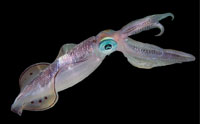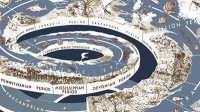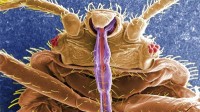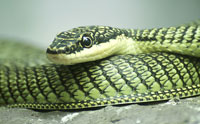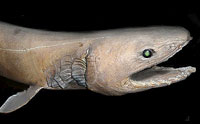By Jeffrey P. Tomkins Based on differences in gene sets and molecular machines between bacteria and eukarya, we continue to demonstrate that unbridgeable evolutionary chasms exist. …read more Read more here: AIG Daily
Wrong evolutionary assumptions about the thymus gland and cot deaths led to the unnecessary demise of many more children. …read more Read more here: creation.com
A University of California Berkley graduate student has discovered two beautiful new species of peacock spiders in southeast Queensland, Australia. The student, Madeline Girard, named the two colorful creatures “Sparklemuffin” and “Skeletorus,” both of the genus Maratus. Are these splendid specimens highly evolved species or have spiders always been spiders? More… …read more Read more here: icr.org
By Jeffrey P. Tomkins In the grand evolutionary paradigm, the origin of the eukaryotic cell represents one of the great mysteries and key hypothetical transitions of life. …read more Read more here: AIG Daily
New claims about this ‘classic’ origin-of-life experiment, but it remains inadequate-and evidence shows the earth always had an oxidizing atmosphere. …read more Read more here: creation.com
A recent discovery indicates our eyelashes must measure at just the right length to function properly. Scientists at the Georgia Institute of Technology studied 22 mammal lash lengths and reported that, from giraffes to hedgehogs, lash length was of “optimum” length—about one-third of the width of the given mammal’s eye. More… …read more Read more here: icr.org
High in the Andes, a furry member of the raccoon family has lived quietly for centuries without detection. …read more Read more here: AIG Daily
For thousands of years man has gazed in awe at the magnificent soaring ability of birds. Today we’ve even made our own winged machines. But it was the Creator’s idea first! …read more Read more here: creation.com
When the workings of the genome were first being discovered, the central evolutionary dogma of molecular biology claimed that genetic information passes consistently from DNA to RNA to proteins. Now we know that RNA messages can be altered by a variety of mechanisms, and a new study in squid genetics has vaulted one of these processes—called RNA editing—to an unprecedented level of biocomplexity. More… …read more Read more here: icr.org
Some say evolutionary advantages led to the average size increase of marine animals in the fossil record, but they assume a timeline of millions of years. …read more Read more here: AIG Daily
A key type of rogue genetic data called orphan genes has just been reported in honey bees. Orphan genes conflict with ideas about genome evolution, and they are directly linked with the evolutionary enigma of phenotypic novelty, unique traits specific to a single type of creature. More… …read more Read more here: icr.org
Can time and chance really produce something as complex as insulin? …read more Read more here: creation.com
Evolutionists credit endogenous retroviruses with making mammalian evolution possible, but scientists now show they play a critical role in brain development. …read more Read more here: AIG Daily
Research shows that bedbugs are still bedbugs. They don’t demonstrate Darwinian evolution—they vary within their created kind to survive in a sin-cursed world. …read more Read more here: AIG Daily
It’s an old story. An animal or plant is discovered in sedimentary rocks by paleontologists and it pushes the organism’s origin further back by many millions of years. This time snakes are the subject of a recent, unexpected discovery that pushes their first appearance back an additional 65 million years. More… …read more Read more here: icr.org
“Excellent article on the complexity of life and the probability of its origin by chance.” Admin How did life begin? The origin of life is a vexing problem for those who insist that life arose through purely natural processes. The naturalistic origin of life is also known as abiogenesis or sometimes chemical evolution. Some evolutionists try to claim that the origin of life is not a part of evolution. However, probably every evolutionary biology textbook has a section on the origin of life in the chapters on evolution. The University of California, Berkeley, has the origin of life included [More]
On January 21, 2015 the news broke—an Australian fisherman hooked a “living fossil.” Called the frilled (or frill) shark, this creature was thought to be 80 million years old. It looks mighty frightening, but is it truly “prehistoric” and somehow linked to shark evolution? More… …read more Read more here: icr.org
Since the dawn of time, people have marveled at the caterpillar’s visible transformation into a butterfly. …read more Read more here: AIG Daily
It has become dogma that human and chimp DNA is ‘only’ 1% different, but this is very, very wrong. …read more Read more here: creation.com
“Lengthy but excellent article addressing many of the issues on the origin of life subject.” Admin This Part begins with the Narrator’s statement: “Ever since the publication of Charles Darwin’s On the Origin of Species, evolution has been fundamentally important to atheism, sometimes even presented as the intelligent alternative to belief in a Creator. … But some scientists reject the stark choice. They argue that Darwin is not a threat to belief and make the case for God and evolution.” In our previous article in this series, on Darwinism, we pointed out that Darwin said he would reject his own [More]
“Lengthy but excellent article addressing many of the issues on the origin of life subject.” Admin Early on, the Narrator states: “For atheists there appears to be no better weapon to derail belief in God than evolution.” Atheist Prof. David Sloan Wilson (Dept of Biology and Anthropology, Binghamton University, New York) backs this up with the rhetorical question: “Do atheists need evolution?” which he then answers: “Yes! Yes! Yes! The very conception of God has been muscled off the scientific playing field.” There’s nothing new about this, of course; atheist William B. Provine has said: “Evolution is the greatest [More]
The electric eel (Electrophorus electricus) lurks in the murky waters of the swamps and rivers of northern South America. With its highly sophisticated system of electrolocation, it is a stealthy predator, having the ability to navigate and hunt in conditions of low visibility. Using ‘electroreceptors’ to detect distortions in an electric field generated within its own body, it can locate a potential meal undetected. It then immobilizes its prey using a powerful electric shock, sizeable enough to stun a large mammal such as a horse, or even kill a man.1 Having a long cylindrical body it closely resembles what we [More]
Is the war on malaria plagued by “rapid evolution of insecticide resistance” in mosquitoes? …read more Read more here: AIG Daily
Is the war on malaria plagued by “rapid evolution of insecticide resistance”? …read more Read more here: AIG Daily
If you’re a fisherman who reckons that fish are now smaller, and there are fewer of them around, you’re very likely right. …read more Read more here: creation.com
Humans have amazing eyesight. In fact, many camera companies have looked to the eye in an effort to glean useful information in developing better photographic and video technology. As effective as the human eye is, however, there are certain things it cannot do. One of those is to detect ultraviolet light. But researchers have recently discovered a creature with the amazing ability to detect ultraviolet light—the mantis shrimp. Mantis shrimp are some of the most interesting creatures in the water. They have extremely powerful claws and lightening fast reflexes. But their ability to see ultraviolet light makes their eyesight one [More]
I’m typing this article on a personal computer. You are most likely reading it on some form of one, whether a desktop, laptop, smartphone or tablet (which are really just small computers). These amazing devices are all around us. Brilliant researchers have spent billions of dollars designing the most functional computers to help people all over the world achieve their goals. You may well know, however, that one computer is more powerful than any that humans have been able to design—the human brain. As LiveScience writer Charles Choi stated, “The most powerful computer known is the brain” (2013). But a [More]




























